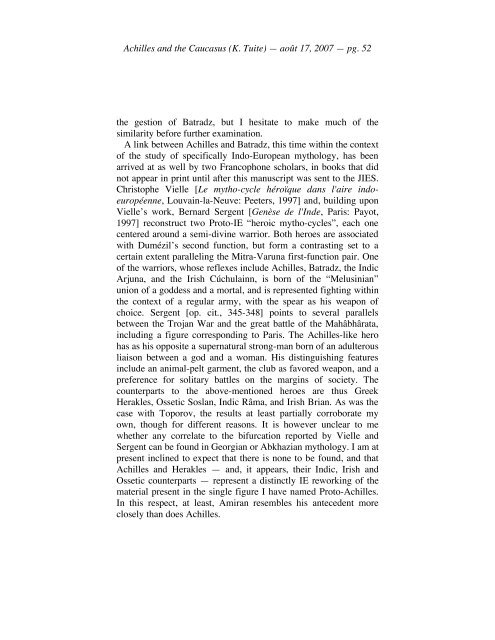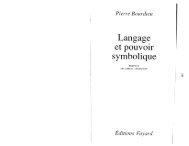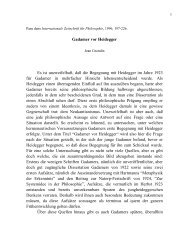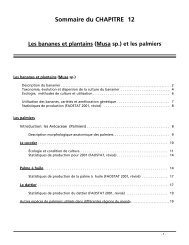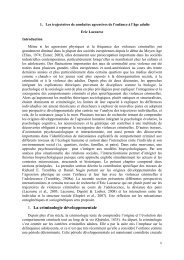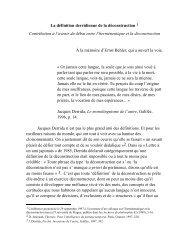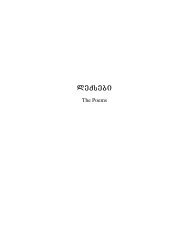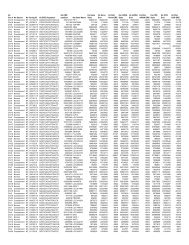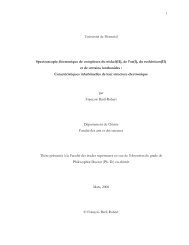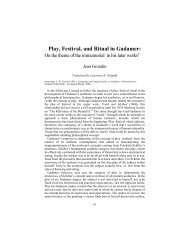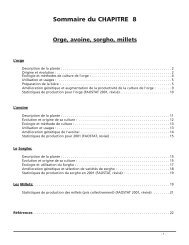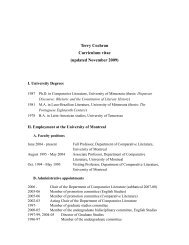Achilles and the Caucasus - Université de Montréal
Achilles and the Caucasus - Université de Montréal
Achilles and the Caucasus - Université de Montréal
You also want an ePaper? Increase the reach of your titles
YUMPU automatically turns print PDFs into web optimized ePapers that Google loves.
<strong>Achilles</strong> <strong>and</strong> <strong>the</strong> <strong>Caucasus</strong> (K. Tuite) — août 17, 2007 — pg. 52<br />
<strong>the</strong> gestion of Batradz, but I hesitate to make much of <strong>the</strong><br />
similarity before fur<strong>the</strong>r examination.<br />
A link between <strong>Achilles</strong> <strong>and</strong> Batradz, this time within <strong>the</strong> context<br />
of <strong>the</strong> study of specifically Indo-European mythology, has been<br />
arrived at as well by two Francophone scholars, in books that did<br />
not appear in print until after this manuscript was sent to <strong>the</strong> JIES.<br />
Christophe Vielle [Le mytho-cycle héroïque dans l'aire indoeuropéenne,<br />
Louvain-la-Neuve: Peeters, 1997] <strong>and</strong>, building upon<br />
Vielle’s work, Bernard Sergent [Genèse <strong>de</strong> l'In<strong>de</strong>, Paris: Payot,<br />
1997] reconstruct two Proto-IE “heroic mytho-cycles”, each one<br />
centered around a semi-divine warrior. Both heroes are associated<br />
with Dumézil’s second function, but form a contrasting set to a<br />
certain extent paralleling <strong>the</strong> Mitra-Varuna first-function pair. One<br />
of <strong>the</strong> warriors, whose reflexes inclu<strong>de</strong> <strong>Achilles</strong>, Batradz, <strong>the</strong> Indic<br />
Arjuna, <strong>and</strong> <strong>the</strong> Irish Cúchulainn, is born of <strong>the</strong> “Melusinian”<br />
union of a god<strong>de</strong>ss <strong>and</strong> a mortal, <strong>and</strong> is represented fighting within<br />
<strong>the</strong> context of a regular army, with <strong>the</strong> spear as his weapon of<br />
choice. Sergent [op. cit., 345-348] points to several parallels<br />
between <strong>the</strong> Trojan War <strong>and</strong> <strong>the</strong> great battle of <strong>the</strong> Mahâbhârata,<br />
including a figure corresponding to Paris. The <strong>Achilles</strong>-like hero<br />
has as his opposite a supernatural strong-man born of an adulterous<br />
liaison between a god <strong>and</strong> a woman. His distinguishing features<br />
inclu<strong>de</strong> an animal-pelt garment, <strong>the</strong> club as favored weapon, <strong>and</strong> a<br />
preference for solitary battles on <strong>the</strong> margins of society. The<br />
counterparts to <strong>the</strong> above-mentioned heroes are thus Greek<br />
Herakles, Ossetic Soslan, Indic Râma, <strong>and</strong> Irish Brian. As was <strong>the</strong><br />
case with Toporov, <strong>the</strong> results at least partially corroborate my<br />
own, though for different reasons. It is however unclear to me<br />
whe<strong>the</strong>r any correlate to <strong>the</strong> bifurcation reported by Vielle <strong>and</strong><br />
Sergent can be found in Georgian or Abkhazian mythology. I am at<br />
present inclined to expect that <strong>the</strong>re is none to be found, <strong>and</strong> that<br />
<strong>Achilles</strong> <strong>and</strong> Herakles — <strong>and</strong>, it appears, <strong>the</strong>ir Indic, Irish <strong>and</strong><br />
Ossetic counterparts — represent a distinctly IE reworking of <strong>the</strong><br />
material present in <strong>the</strong> single figure I have named Proto-<strong>Achilles</strong>.<br />
In this respect, at least, Amiran resembles his antece<strong>de</strong>nt more<br />
closely than does <strong>Achilles</strong>.


